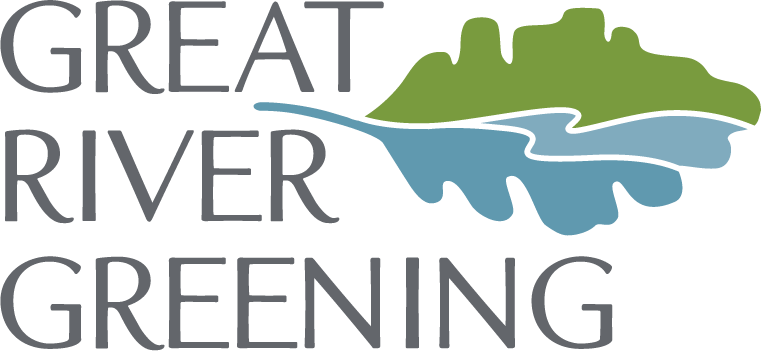
2023 Annual Report
A Leap Year
In the world of prairie restoration, there is a well-known saying about the growth and flowering of newly seeded native plants: “The first year it sleeps, the second year it creeps, and the third year it leaps!” In 2023, Great River Greening experienced its own leap year. We achieved record-breaking successes in volunteer participation and engagement, acres of land restored and sustainably managed, and funding for new programs. All these accomplishments were made possible thanks to the dedicated support and collaboration of our community partners, volunteers, and donors.
In this Annual Report, we highlight why 2023 marked a significant leap year for Great River Greening’s land restoration and sustainable management efforts. As we look ahead, we recognize our work will only continue to be needed. We are committed to stepping up and supporting communities committed to making a positive impact on green spaces throughout Minnesota.
Thank you to all the individuals, foundations, corporations, and partners who contribute their time, skills, passion and dollars to this critical work. This remarkable leap year of growth would not have been possible without your support.
In gratitude,
Kateri
Launched in January 2023, in partnership with the City of Saint Paul, Saint Paul Public Schools and community residents, this pilot tree canopy program aims to mitigate the devastating effects of urban heat islands that disproportionately affect low-income areas and communities of color. Led by Great River Greening, and in collaboration with a consultant specializing in racial, health, and environmental equity, this large-scale, multi-year planting initiative was launched with community-based input, leading to the planting of 170 trees (and counting).
COOL SAINT PAUL
Building on a successful launch in 2022, Great River Greening expanded our youth environmental education program in 2023. In partnership with three schools in Minneapolis and the East Metro of St. Paul, our naturalist engaged over 600 students (grades 3-10) in hands-on planting, restoration, and environmental stewardship experiences. Students benefit from spending time in nature, which enhances their success in school, at home and in their communities.
FUTURE STEWARDS
Launched in January 2023, Great River Greening initiated a bold plan to mitigate the effects of climate change in Minnesota and protect our natural systems and habitats. Our vision for 2030 is healthy, climate-resilient ecosystems throughout the state of Minnesota. Recognizing the urgent need to address our climate future in this decade and the shared desire of Minnesotans to address climate change through nature-based solutions, Great River Greening will leverage the expertise of our ecologists and naturalists to restore Minnesota’s habitats to health and resilience.
VISION FOR 2030
$10M GRANT FROM USDA FOREST SERVICE
Great River Greening was awarded $10 million from the USDA Forest Service to implement a 5-year coalition-building program called Cooling Minnesota Communities. The program aims to combat extreme heat, enhance climate change resilience, and increase equitable access to tree canopies across Minnesota. Our award is one of the highest funded programs in the nation, bringing together 14 partners to remove dead and diseased ash trees, educate communities and youth about urban tree canopies, and plant and water 10,000 trees in key urban and community heat islands over the next five years
As we introduce new programs and initiatives, we have not wavered in our commitment to restoring habitats to health. This year, we created and improved resilient habitats and addressed biodiversity loss through management and adaptive plantings on over 5,000 acres. Through 2024, we are expanding our Pollinator Central Corridor project to include an additional 800 acres of critical new pollinator habitat throughout central Minnesota, a habitat that is in decline and is essential for pollinators.
LAND RESTORATION WORK
Our work supports thriving economic and environmental outcomes through entrepreneurship by promoting regenerative agricultural practices like silvopasture (grazing animals in woodlands and savannas), planting cover crops, and growing perennial grains. Historically neglected wooded areas and croplands are now being managed through browsing and Continuous Living Cover (CLC) crops to provide habitat for birds, pollinators, and other wildlife. Our work with farmers and community members in Nicollet Country through education, consultation, and technical assistance has resulted in the planting of 4,400 new acres of CLC in the area, improving soil health water quality and capturing carbon,
BRIDGING AGRICULTURAL AND NATURAL SYSTEMS
2023 BY THE NUMBERS
10,809 ACRES
Land restored or sustainably managed – over 4,000 acres more than any previous year, a record-breaking achievement.
600+ FUTURE STEWARDS
Youth engaged in hands-on planting, restoration, and stewardship work, setting a record.
5,720 VOLUNTEERS
Number of people who donated their time and skills, breaking previous records.
21,885 HOURS
Time spent by volunteers conserving and caring for Minnesota’s natural resources (highest ever).
42,563
Number of trees, shrubs, grasses and wildflowers planted.
125,812 METRIC TONS
Amount of carbon sequestered through restoration and sustainable management at our project sites—
equivalent to removing 27,350 cars off the road.







